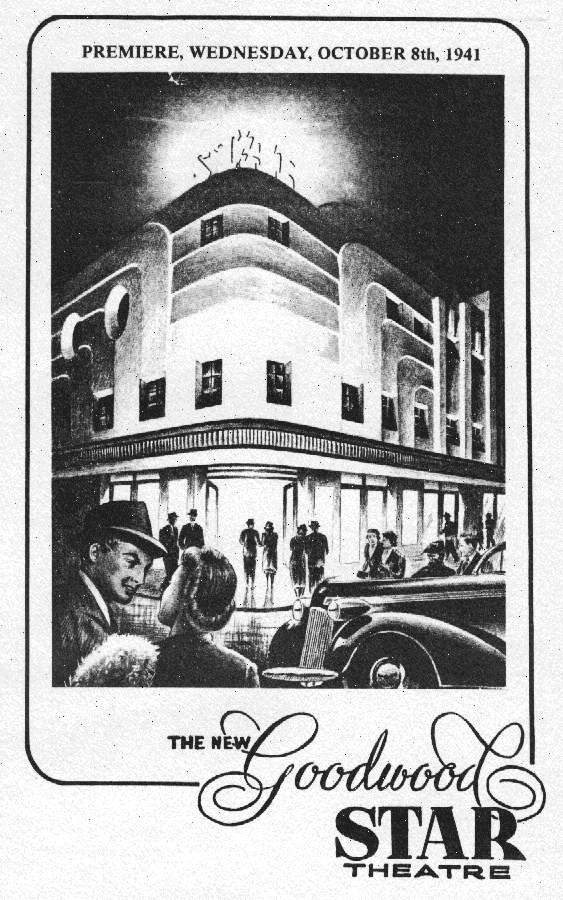
Back to South Australia Contents page
Capri Theatre, Goodwood

The New Goodwood Star Theatre, as it was then known, was opened by the D
Clifford circuit on 8 October, 1941, a few doors away from the original Star
Theatre. It was the last theatre to be built by Dan Clifford, who died on 10
December, 1942. [John Thiele and Ross Lange, Thanks for the Memory,
Theatre Organ Society of Australia, Adelaide, 1991, p. 68] Built in the
stylish "depression moderne" image, its luxurious
auditorium seated 1472 persons amidst a décor of
geometric shapes, sweeping curves and concealed
lighting. In acknowledgment of the war then in
progress, a "V for Victory" motif was incorporated in
the main ceiling decoration.
The theatre passed into the hands of Greater Union in
1947, after which it became known as the Odeon, but
whether this appellation was displayed on its exterior is
uncertain. In 1964, when the old Star, then the Curzon,
closed, the vertical "Curzon" sign from that theatre
took a trip along the road to be re-erected at the Odeon,
which was now to be known and designated as "The
New Cinema Curzon". It continued in this guise for
some three years before its final change of name to
Capri, its full title being "Cinema Capri - The
International Cinema", 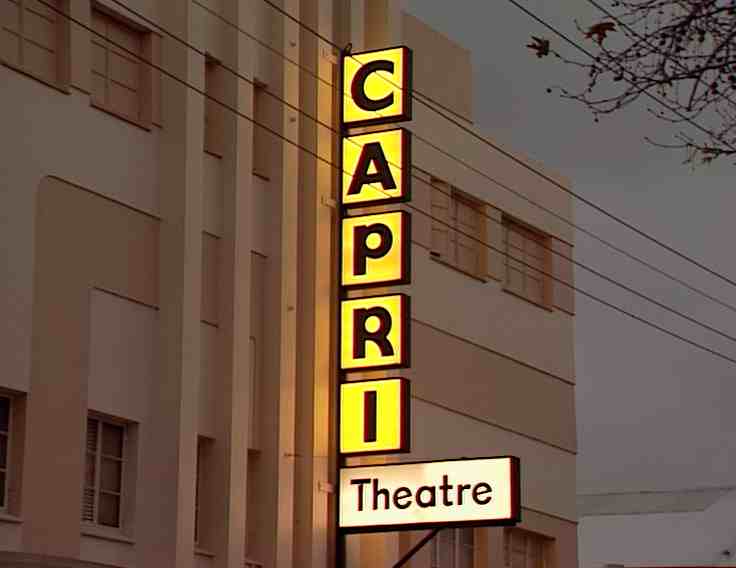 occurred in 1967. Many
alterations had been made to the
theatre immediately prior to this
change. The number of seats was
reduced from 1472 to 851, curtains covered the walls and
their decorations, suspended light fittings were installed -
chandeliers in the auditorium, suspended globes in the
candy bar, which was extended to form a coffee bar. Even
the usherettes' uniforms were of traditional Italian design. Many other changes
were incorporated to give the theatre an "international" appearance. [John Thiele and
Ross Lange, Thanks for the Memory, Theatre Organ Society of Australia, Adelaide, 1991, p. 74-88]
occurred in 1967. Many
alterations had been made to the
theatre immediately prior to this
change. The number of seats was
reduced from 1472 to 851, curtains covered the walls and
their decorations, suspended light fittings were installed -
chandeliers in the auditorium, suspended globes in the
candy bar, which was extended to form a coffee bar. Even
the usherettes' uniforms were of traditional Italian design. Many other changes
were incorporated to give the theatre an "international" appearance. [John Thiele and
Ross Lange, Thanks for the Memory, Theatre Organ Society of Australia, Adelaide, 1991, p. 74-88]
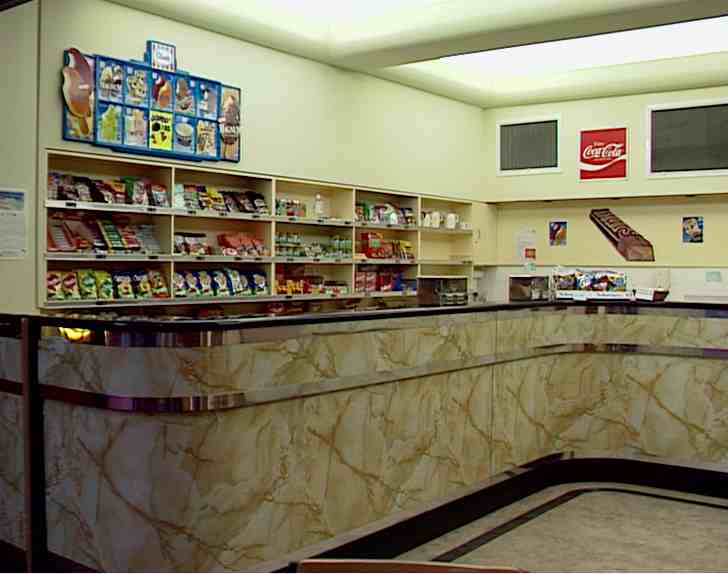
Photo: Wayne Bertram
For the first time, live organ music was heard during shows, as a Thomas electronic organ was installed on the left of the stage. This was played nightly by Les Jones for a six-month season of "A Man and a Woman", the film screened on opening night, 16 November, 1967. [John Thiele and Ross Lange, Thanks for the Memory, Theatre Organ Society of Australia, Adelaide, 1991, p. 74-88] Falling audience numbers caused Greater Union to decide to close and sell the theatre in 1978; in this case it was not, as one might expect, demolished or converted to some other use, but was purchased by the South Australian Division of TOSA. At this point, we need to go back a few years to understand what led to this very unusual out-come.
TOSA had successfully relocated the twelve-rank Wurlitzer organ from the Plaza Theatre, Melbourne, to Pulteney Grammar School, where it was opened in 1970. Having completed this project, the Society was ready to tackle an even more ambitious project. A special meeting in 1974 approved the purchase of the four manual, sixteen-rank composite organ which had been in storage at Mike Pfitzner's house in Darwin. Pfitzner had bought the instrument from Penn Hughes, who had gradually built it up in his home in Sydney over a period of some years. Conditions in Darwin were not conducive to the erection of a large and complex residence pipe organ, and after numerous setbacks, Mike finally agreed to sell the instrument to TOSA. A six-person team from Adelaide, who became known as the "Darwurlians", flew to Darwin in late 1974, and loaded the organ into the truck in which it made the trek across the desert to Adelaide. They could have had little prescience of the urgency of their work, but within a month, Darwin was devastated by Cyclone Tracy on Christmas Day, 1974, when Mike and his family were forced to take shelter in the empty area which had been set aside for organ chambers, as their house collapsed around them.
With the organ safely in Adelaide, TOSA embarked on two activities - to restore
and rebuild the organ, and to find a
permanent home for it. In the meantime, most
of it was stored at Spicer Memorial Methodist
Church hall, St Peter's, where the overhaul
work got under way. The component parts of
the organ were at this time exactly as they
had been in Penn Hughes' residence and
comprised pipework by Wurlitzer, Christie
and Conacher, controlled from the former
"slave" console from the State Theatre,
Melbourne:
Tuba Horn, Open Diapason, Clarinet, Viol d'Orchestre, Viol Céleste, Flute, Vox Humana - Wurlitzer, ex-Wintergarden, Brisbane (via. Plaza, Sydney)
Kinura - Wurlitzer, ex-King's Cross, Darlinghurst (via. Savoy, Hurstville and Congregational Church, Burwood)
Oboe Horn - Wurlitzer, ex-Regent, Wentworthville
Tibia, Melodia, Clarinet - Christie, ex-Palatial Theatre, Burwood, NSW
Viol, Orchestral Oboe, Vox Humana - Christie, ex-Empire, Dunedin, N.Z.
English Horn - Conacher, ex-Regal, Southampton, U.K.
During the overhaul period, three additional ranks, a Dodd Tibia, an Oboe Horn and a Harmonic Tuba, were acquired, bringing the total pipe stock to nineteen ranks.
Meanwhile, the search for a suitable building in which to locate the instru-ment continued. In June, 1978, a special meeting of TOSA was called at the Capri Theatre, where members were informed that the theatre was available for sale. A vote was taken and it was decided that TOSA should negotiate to acquire the Capri. [Jan Rover, Capri Corner, "SA TOSA News", TOSA, Adelaide, May, 1985, p. 7] After some anxious months, TOSA members were happy to read in January, 1979, . [TOSA now the Proud Owner of the Capri Cinema, "SA TOSA" News, TOSA (SA), Adelaide, January, 1979, p. 1] that their Society had acquired the theatre on 15 December, 1978, and had re-opened it as a commercial cinema from 26 December, 1978. The purchase price was $145,000, of which $120,000 was funded by a 20-year bank loan, the balance being loans and donations from TOSA members. [Concert programme, opening of Capri organ, 2 April, 1983, p. 20] The theatre was (and still is) operated with a professional manager and key staff, with TOSA volunteers assisting in many varied capacities. The level of professionalism displayed was confirmed when the accounts showed that during its first year of TOSA operation, the theatre made a net profit of $24,189. [TOSA Income and Expenditure Statement, 1979, "TOSA News", TOSA, Adelaide, March, 1980, p. 12]
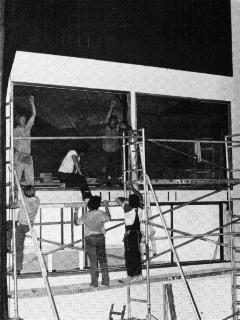
Photo: Wayne Bertram
Naturally, the acquisition of a venue spurred on the efforts to rebuild the organ, and a new task arose - the construction of organ chambers in the Capri. Plans for the construction work were approved by Unley Council in 1980 and work could then proceed. [News Spot, "SA TOSA News", TOSA, Adelaide, September, 1980, p. 4] The original proscenium arch was re-moved, and spacious chambers, which could accommodate with ease far more than the current nineteen ranks were created on each side. They were built with large glass viewing windows, with the swell shutters high above. Lights are placed in the chambers so that when the organ is played its entire pipes and mechanisms can be clearly seen by the audience. At other times, the chambers are concealed behind curtains. Audiences were given a foretaste of what was to come when a Conn electronic organ was installed in the theatre in 1981. [News Spot, "SA TOSA News", TOSA, Adelaide, May, 1981, p.4]
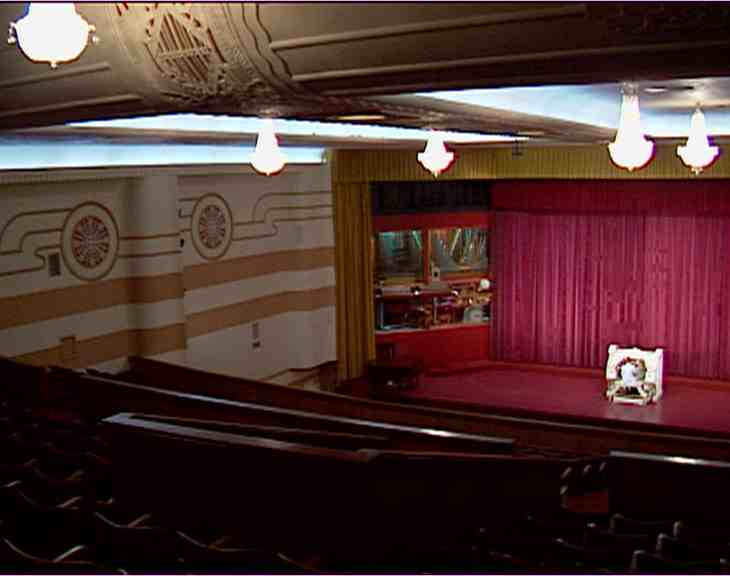
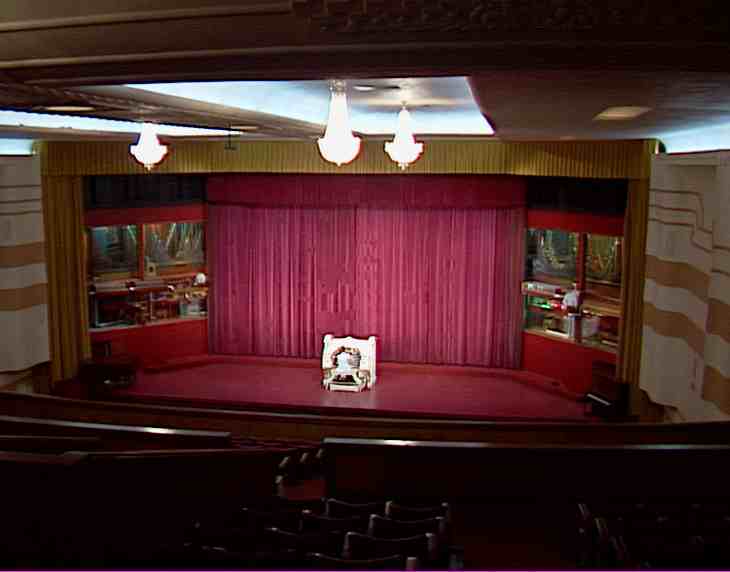
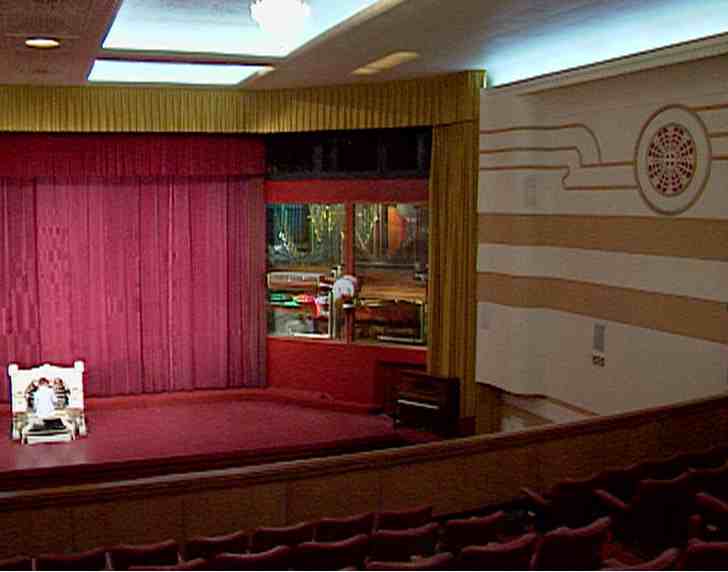
Photos: Wayne Bertram
The organ was first heard at its official opening on 2 April, 1983, with Tony Fenelon, Ray Thornley and John Atwell at the console. Thirteen ranks were available for this occasion, which must have tested the nerves of the organists to the extreme. Work had fallen behind schedule, despite the installation crew working for 36 hours non-stop, and it was only six hours before the doors opened that the final connections were made and the organ was playable.
"On Friday, April 1, the instrument was about a 4/1 or 2. Overnight it became a 4/13... The three artists had virtually no time to practise. And we knew there were "bugs" in the organ - for example, if any notes were played on the Solo and Bombarde manuals at the same time, the Post Horn played on that note, and believe me, the Post Horn is almost a Serpent! The problem, solved a week later, was found to be a blob of solder on a board.
"Notes on the Xylophone and Glockenspiel were falling out occasionally. This was caused by the heat in the chambers. The organ had been on continuously for 72 hours. Some notes just decided to play by themselves now and then...
There were no presets available, and it was definitely a show of perseverance on the part of the three premiering organists to perform without them." [Wayne Bertram, Adelaide Group's Purchase, Operation of Theatre Pays for Pipe Organ Purchase, Installation, "The Console", Pasadena, USA, July, 1983, p. 15].
Few in the audience would, however, have realised that none of the organists had even played through a complete tune on it before the concert, and that none of them had any real idea of how it was going to sound. It was a tribute to the professionalism of the organists that the opening concert went off with scarcely a hitch.
"There were problems with the electronics which caused some stops to drop out and others to come on unexpectedly when not required. As the organ is not yet fully installed, the organists had to remember just what was not connected as well as cope with what 'dropped out' or what 'came on' unexpectedly, and what was out of tune. Less skilled and experienced organists than our trio of Tony Fenelon, Ray Thornley and John Atwell would not have carried the con-cert through with such aplomb. They held the audience throughout, and at the conclusion, received a tremendous and heart-warming ovation. Space does not permit the listing of the programme; let me sum up by saying 'a won-derful, wonderful, exciting night which will not be forgotten.' It stands out clearly that when all is in place and working perfectly, this combination of cinema and organ offers limitless potential for the future." [Ellis, Frank, South Australian Division Pulls Out all the Stops: The National Convention, "SA TOSA News", TOSA, Adelaide, June, 1983, p. 6]
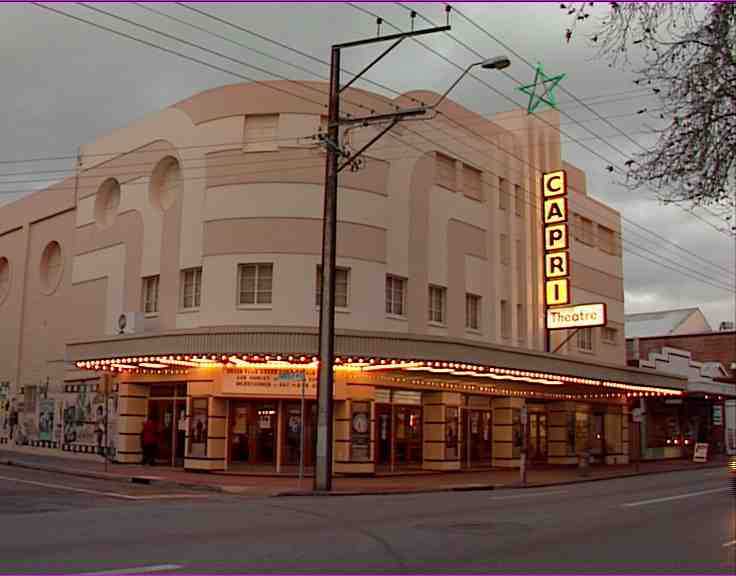
Photo: Wayne Bertram
As opened, the organ was fitted with a time-multiplexing control system in place of the traditional system of switches and relays, which meant that the console was linked to the chambers by a cable con-taining only 56 wires instead of 1216 which the normal system would have required. The system was designed by a TOSA member, and was an innovation in Australia.
As time passed, the number of ranks in operation gradually increased. A major improvement was completed in 1987 when the console was enabled to rise to stage level on a lift. [Capri Corner, "SA TOSA News", TOSA, Adelaide, March, 1987, p. 6] This was the first time that an organ console had risen on a lift in Adelaide.
During this time, the commercial operation of the theatre had proceeded so successfully that the bank loan was able to be paid off over ten years early, so that in June, 1988, TOSA was able to announce that it owned the theatre - freehold. [The Capri Theatre is Now Ours - Freehold, "SA TOSA News", TOSA, June, 1988, p. 1]
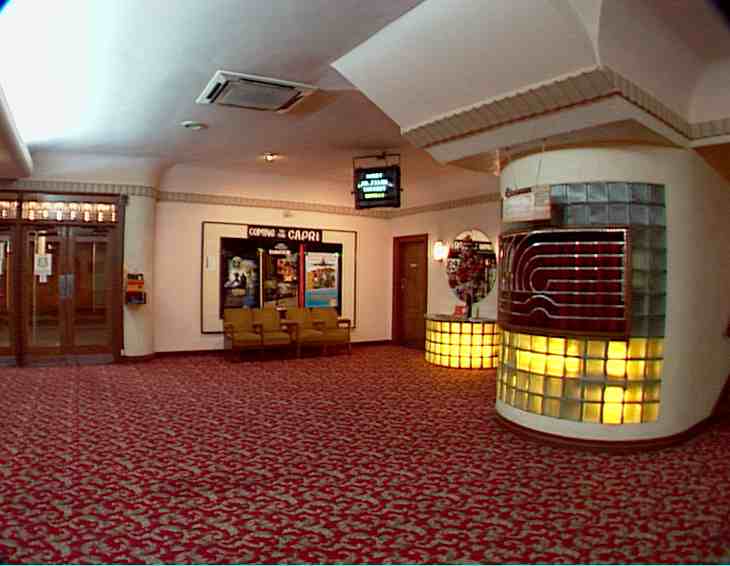
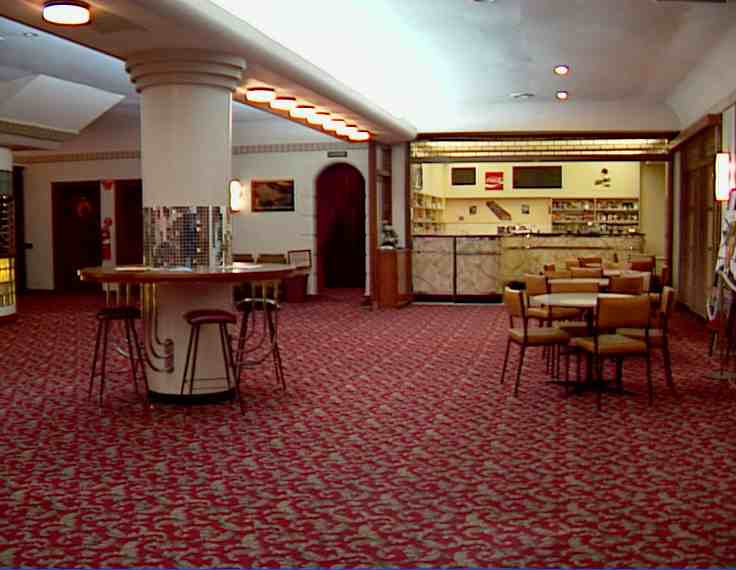
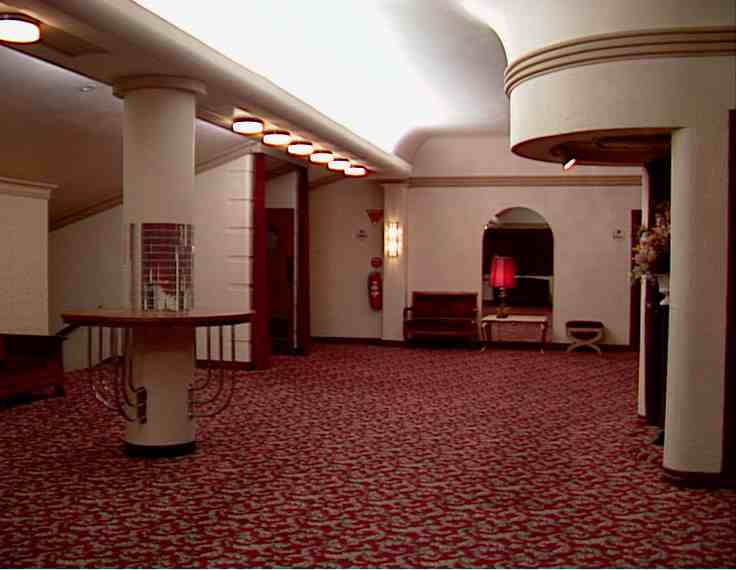
Photos: Wayne Bertram
At the end of 1988, it was decided to replace the time multiplexing system used to control the organ with a state-of-the-art computerised control system by Devtronix (America), a type of system which had been successfully installed on a number of American theatre organs. [Capri Organ to be Computer Controlled, "SA TOSA News", TOSA , Adelaide, December, 1988, p. 5] By June, 1989, the new system had been installed, and the organ was back in use. [From the President, "SA TOSA News", TOSA, Adelaide, June, 1989, p. 3]
The size of the organ continued to grow, as additional ranks were acquired from numerous sources in Australia and America. It is interesting to examine its sound in the many recordings issued between its initial opening and its completion, as the ranks were added and replaced.
By 1995 it was complete as a four manual, twenty-nine rank instrument, and American experts Walt Strony and Ed Zollman were commissioned to spend some weeks in Adelaide, directing the voicing and tonal finishing.
"During the first three weeks of their stay, Ed and Walt worked solidly at the Capri organ, achieving some remarkable results in around 270 hours. They systematically worked through the organ, spending as much time as necessary to ensure that each pipe would blend with the final sound they were seeking. It was interesting to hear the ranks of pipes become more balanced in quality and volume as Ed worked on each pipe to create an ensemble effect - those who heard the process were in awe of the technical skills and incredible ears that Ed and Walt possess." [Gail Ward, Ed Zollman and Walt Strony's Visit to Adelaide - Some Highlights, "SA TOSA News", TOSA, January-February, 1996, p. 9]
Walt Strony demonstrated the results of their work to an enthralled audience on 5 December, 1995, when for the first time the organ was heard as a complete entity, with all ranks regulated to match each other and the building. The effect was a revelation:
"A large and expectant audience came along to hear the results of this long project that had finally come to fruition. Listening to the comments in the foyer after the concert, it was clear that the orchestral ensemble effects of the completed Capri organ had more than pleased the audience. There were many compliments about the tonal integrity of the instrument and particular bouquets for the now abundant eight ranks of shimmering strings." [Gail Ward, Ed Zollman and Walt Strony's Visit to Adelaide - Some Highlights, "SA TOSA News", TOSA, January-February, 1996, p. 9]
The organ's ranks are now:
Main Chamber (left)
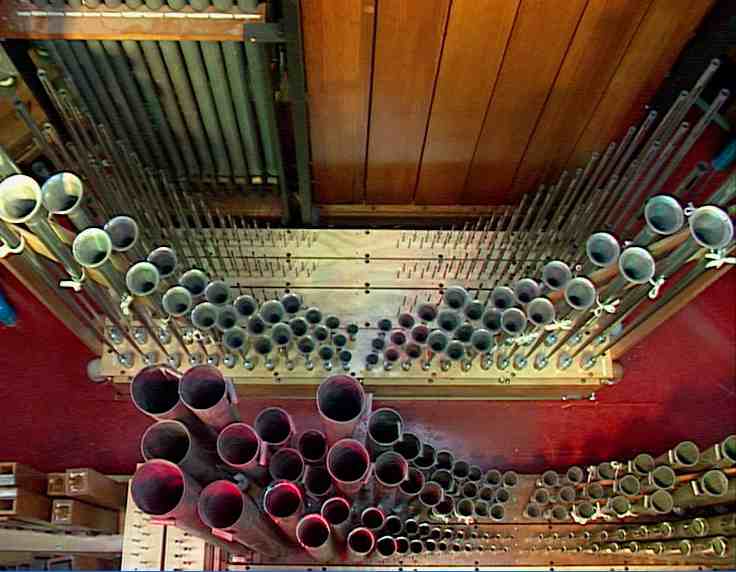
Photo: Wayne Bertram
Diapason - Wurlitzer (ex-Wintergarden, Brisbane)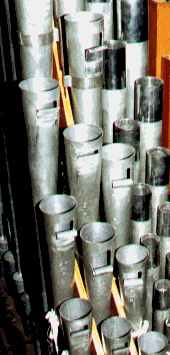
Flute - Wurlitzer (ditto)
Flute Céleste - Wurlitzer (ex-USA)
Musette - Trivo (new)
Salicional - Christie (ex-Empire, Dunedin)
Salicional Céleste - Wurlitzer (ex-Ernie Manley res., Seattle)
Gamba - Christie (ex-Empire, Dunedin)
Gamba Céleste - Wurlitzer (ex-USA)
Viol d'Orchestre - Wurlitzer (ex-Wintergarden, Brisbane)
VdO Céleste - Wurlitzer (ex-Ernie Manley res., Seattle)
Tibia Clausa - Dodd (ex-Elder Hall, Adelaide), Kimball bass
Trumpet - Trivo (new)
Tuba Horn - Wurlitzer (ex-Wintergarden, Brisbane)
Vox Humana - Christie (ex-Empire, Dunedin)
Unenclosed
Chrysoglott - Wurlitzer
Toy Counter - Wurlitzer
Solo Chamber (right)
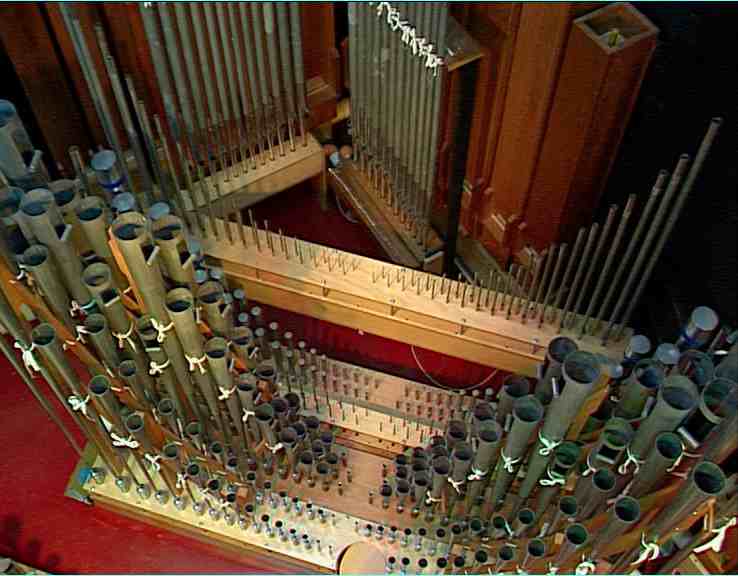
Photo: Wayne Bertram
Clarinet - Christie (ex-Palatial, Burwood)
English Horn - Trivo (new)
Harmonic Tuba - Wurlitzer (ex-USA)
Kinura - Wurlitzer (ex-King's Cross Theatre, Sydney)
Lieblich Flute - Wangerin
Oboe Horn - Unknown (ex-church)
Orchestral Oboe - Trivo (new)
Quintadena - Stephens
Solo String - Robert Morton (ex-Gerry Duffy res., Portland)
String Céleste - Robert Morton (ditto)
Tibia Clausa - Stephens (new - Wurlitzer copy)
Vox Humana - Wurlitzer
Horn Diapason - J B Meyer & Sons
Saxophone - Trivo (new)
Unenclosed
Piano - Kimball
Chimes - Wurlitzer
Glockenspiel - Wurlitzer
Xylophone - Wurlitzer
Sleigh Bells - Wurlitzer
Rear of Stage
Diaphonic Diapason - Wurlitzer (44 notes - available only on Pedal)
Tibia Clausa (bass) - Kimball (13 notes)
Marimba Harp - Wurlitzer
Total Pipes: Main 1069, Solo 950, Stage 57, Total 2076
Click here for great diagram of console layout
The four-manual console contains 273
stopkeys. There are three General
stopkeys, one of which mutes the
appropriate Célestes from whichever
string ranks are in use (all string ranks
are normally double ranks), another
mutes Célestes from the Concert Flute,
the third causes the percussions
(Marimba, Glockenspiel, Xylo-phone)
to reiterate. The organ is unusual in
containing two acoustic 32ft stops, a
Grand Resultant, and a Tibia Resultant. The composition of each varies
according to what other Pedal stops are drawn, so that the effect remains in
balance. The Grand Resultant therefore draws from the Tuba Horn, Tibia Clausa,
Diaphone and Open Diapason ranks as appropriate, at various pitches. The Tibia
Resultant comprises the Flute at 16 and 10 2/3ft pitches, the Tibia also being
added at 10 2/3ft if all the 16ft
flue and diaphone basses are
also drawn. The Great manual
contains a four-rank Mixture
(19, 22, 26, 29), the unison
pitches drawn from the Open
Diapason, the quints from the
Horn Diapason.
Other special effects available include sustain, legato touch, sostenuto (selective sustain), a melody coupler, transposer and MIDI connection. The Solo manual includes intramanual couplers at 6 2/3, 5 1/3 and 4 1/7 pitches in addition to the more normal Sub Octave, Octave and Unison Off couplers.
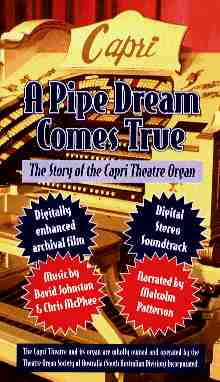 As the control system is computer-based, it is possible to
vary the specification virtually at will, to link any rank (or
part of a rank) to any stopkey, by a simple adjustment to
the program. It is also possible to record anything played
on the organ and play it back at a future date with total
reproduction of notes, stops, swell controls, etc., so that
organists can play duets, trios, or more by successively
re-recording their performances. The organ can
reproduce recordings when no organist is present.
As the control system is computer-based, it is possible to
vary the specification virtually at will, to link any rank (or
part of a rank) to any stopkey, by a simple adjustment to
the program. It is also possible to record anything played
on the organ and play it back at a future date with total
reproduction of notes, stops, swell controls, etc., so that
organists can play duets, trios, or more by successively
re-recording their performances. The organ can
reproduce recordings when no organist is present.
It should be recalled that all these special effects are purely optional extras for the organist, and that the organ can be played just as a very fine traditional theatre organ, as Jesse Crawford and his contemporaries did in the 1920s. It is an instrument which belies its eclectic components, as its overall sound achieves a conceptual unity as an instrument designed and built as a single entity.
Of particular interest is a video recording "A Pipe Dream Comes True" issued by TOSA in 1997. This hour-long tape in digital stereo shows in detail the story of the organ from the time of its purchase by TOSA and removal from Darwin up to 1997.
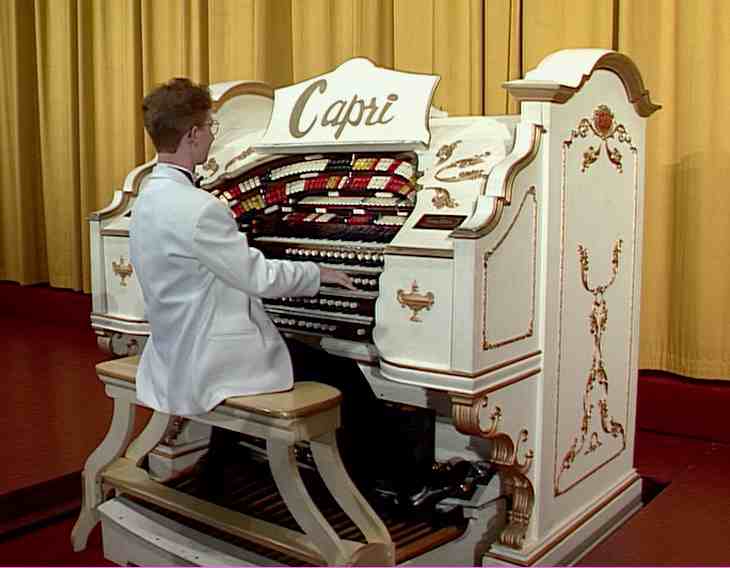
Chris McPhee at the Console
Photo: Wayne Bertram